2020: A Year of enhanced customization and sustainability
In 2020, the retail industry will be shaped by emerging technologies that will change the way consumers interact with brands, while retailers will collaborate more than ever with tech startups to future-proof their businesses.
The consumer is at the center of technological innovation, as retailers struggle to keep the attention of hyper-connected consumers and to keep up with fast-changing expectations. Retailers will increasingly rely on augmented reality (AR) and virtual reality (VR) to enhance the customer experience, while improved automation will boost supply chain efficiency. With the steady increase in competition, large retailers and brands are increasingly recognizing the enormous potential offered by highly specialized startups. Enterprises will continue to invest in startup technologies to sharpen their competitive edge.
We’ve highlighted the top 10 tech startup trends for 2020 that we believe will enable retail to become stronger and better equipped to meet fast-changing consumer demand, to better understand consumer behavior and to create increasingly customized offerings.
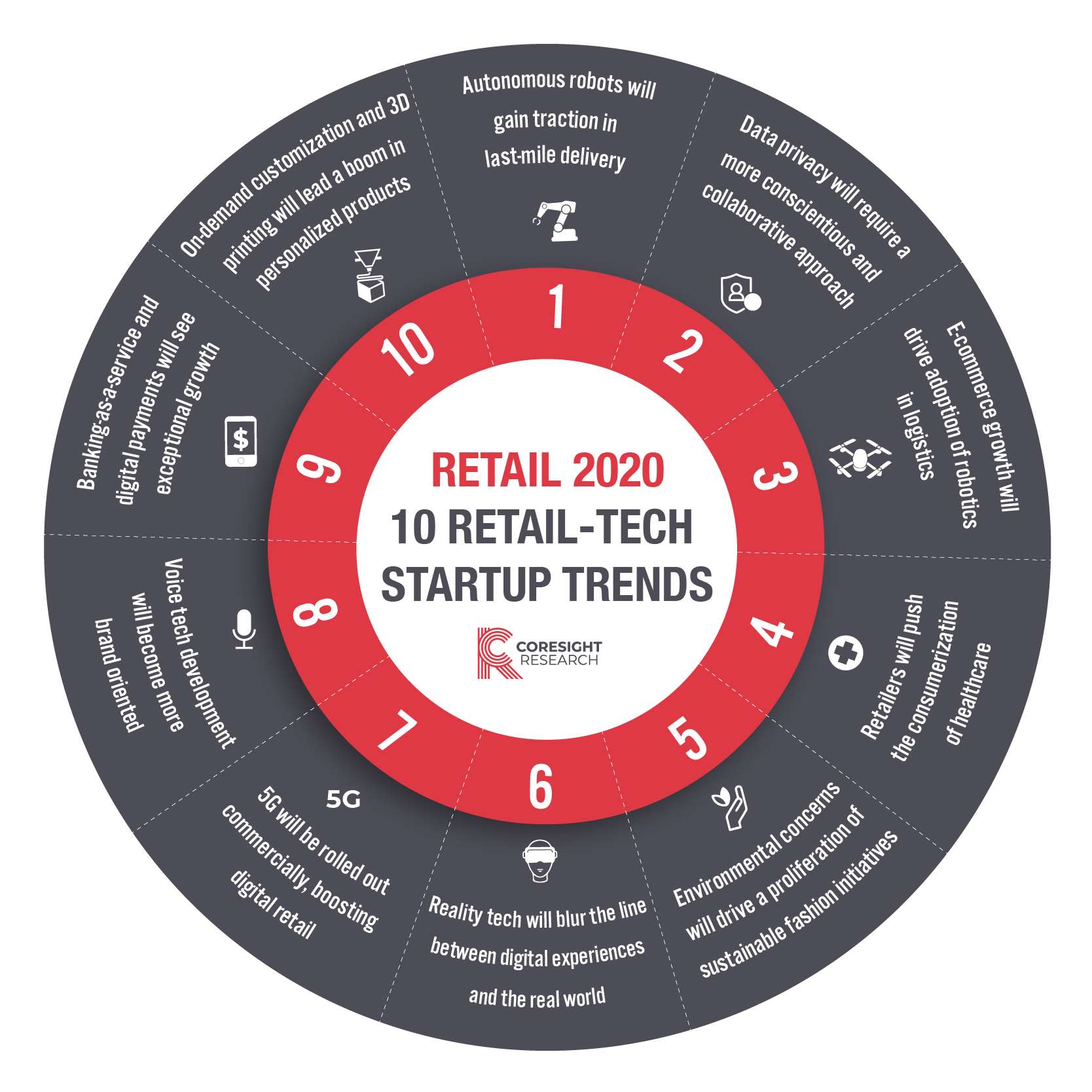 1. Autonomous robots will gain traction in last-mile delivery
1. Autonomous robots will gain traction in last-mile delivery
Investment in autonomous last-mile delivery solutions will increase in 2020, with large industry player acquisitions and partnerships, as well as venture capital investment. The need to improve delivery efficiency and reduce logistics costs will power the development of more advanced and cost-effective aerial delivery drones and ground delivery solutions.
More robots will be trained to recognize objects by their semantic (natural language) labels, giving them a sense of what things are, in real-time, as well as being able to interact with customers. MIT engineers, for example, created a navigation method that enables robots to plan out a route using semantic terms, such as "front door" or "garage," rather than coordinates on a map.
With further advancements and lower costs, we expect to see wider adoption of robotic and drone last-mile delivery solutions. We also expect AI to play a larger role in streamlining delivery operations in 2020 to reduce distribution costs and streamline last-mile delivery. Startups and larger, more established retailers are developing solutions for autonomous-based last-mile delivery, including:
[caption id="attachment_102540" align="aligncenter" width="580"]
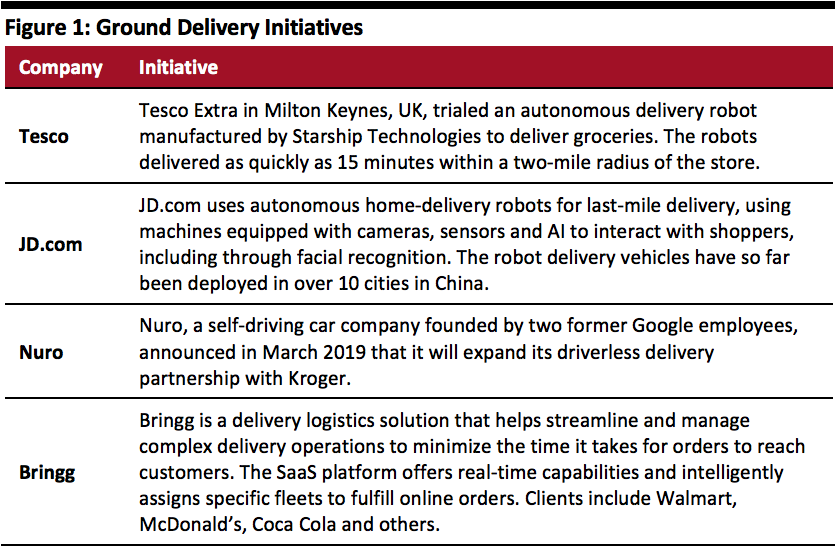 Source: Company reports/Coresight Research
Source: Company reports/Coresight Research[/caption]
Aerial delivery drones will finally see more use, led by Amazon, UPS, Uber, and Google’s Wing. Major retailers are also investing in drone technology for last-mile delivery.
[caption id="attachment_102541" align="aligncenter" width="580"]
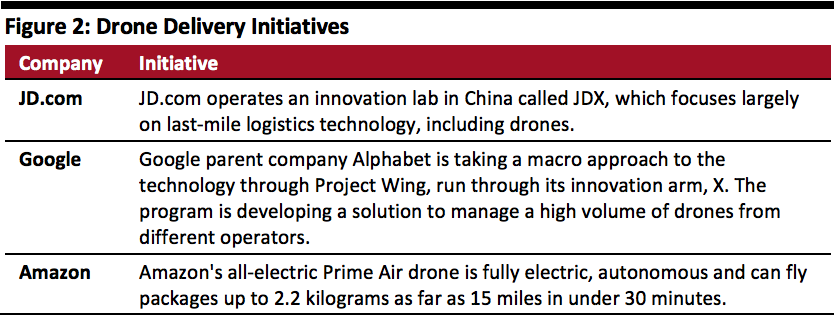 Source: Company reports/Coresight Research
Source: Company reports/Coresight Research[/caption]
2. Data privacy will require a more conscientious and collaborative approach as retailers walk a tightrope between data privacy and personalization
The introduction of the EU’s General Data Protection Regulations (GDPR) and the California Consumer Privacy Act (CCPA) are ushering in a new era for retailers. Most companies do not track the data they collect or where it’s stored, which worked well before but may not work with the new regulations. This increases the risk of privacy violations, regulatory action, security incidents and customer backlash.
Retailers will have to implement new policies to comply with the new regulations and most importantly support the new policies with technologies that safeguard customer data while also ensuring it can be leveraged for useful insights.
Enterprises across the world are increasing investment in data compliance, privacy and governance: The data privacy market is forecast to be worth $158 billion by 2024, according to Market Research Engine.
In 2020, we expect to see more retailers and brands introduce data privacy practices in collaboration with startups.
These are some companies to watch:
[caption id="attachment_102542" align="aligncenter" width="580"]
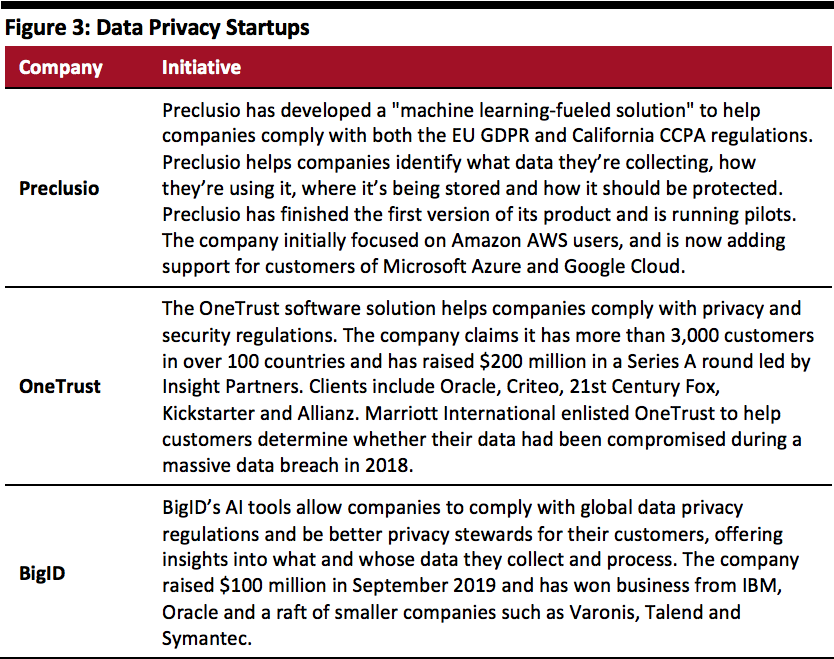 Source: Company reports/Coresight Research
Source: Company reports/Coresight Research[/caption]
The increased limitations on harvesting consumer data also mean contextual marketing—which thrives on consumer engagement based on real-time behavior—will have to shift data collection to be less invasive. We expect more solution providers to offer more data collection tools to comply with these new requirements while also delivering results.
- Anagog, an Israeli startup, uses smartphone sensors that offer retailers insights into customer activities, whereabouts and context. By building customer behavior profiles, Anagog’s Edge-AI technology helps retailers better understand the customer’s lifestyle and routines, in real-time. Then, it provides highly personalized and contextual offers. Its AI engine runs on the mobile device itself, enhancing user privacy because there’s no need to transmit data to a central server, so no private data leaves the phone without the customer’s permission. Skoda is one of its main clients.
3. E-commerce growth will drive adoption of robotics in logistics
In 2020, robotics will significantly enhance the speed and efficiency of operations, boosting productivity, enhancing the consumer experience and delivering more accurate and reliable results. Sales of logistics robotics (the most significant application in retail) increased 53% year over year to $3.7 billion in 2018 (latest), according to the International Federation of Robotics.
Warehouses are central to supply chain management, and some of the most exciting innovations in the field focus on making them smarter. Innovations in robotics are optimizing and automating the storage, packing, and flow of goods within warehouses, making the flow of goods more efficient. Amazon has greatly benefited from robotics, lowering operating costs by 20% in recent years and creating a 50% gain in warehouse space due to more efficient use, according to Business Insider.
[caption id="attachment_102543" align="aligncenter" width="700"]
 Source: Wolfe Research
Source: Wolfe Research[/caption]
Retailers are already implementing robotics in daily operations, often in collaboration with technology firms.
These are some companies to watch in 2020:
[caption id="attachment_102544" align="aligncenter" width="580"]
 Source: Company reports/Coresight Research
Source: Company reports/Coresight Research[/caption]
4. Retailers will push the consumerization of healthcare, especially as it relates to aging
Retailers will increasingly push into healthcare products and services in 2020 and beyond. products and services that address the health effects of aging. Retailers are already integrating healthcare products and services into their businesses, which not only helps diversify revenue streams but also offers new ways to attract shoppers to the store.
Both
CVS and
Walgreens are planning to remodel stores over the next few years to create more room for healthcare products and in-store clinics. Other examples include:
[caption id="attachment_102545" align="aligncenter" width="580"]
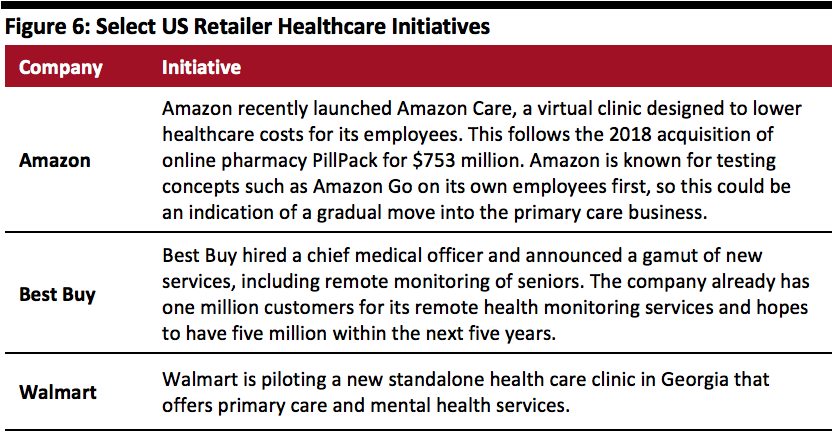 Source: Company reports/Coresight Research
Source: Company reports/Coresight Research[/caption]
2020 will likely see more activity in this space as the majority of millennials cross into their thirties and start families of their own. Startups innovating around fertility and reproductive health have raised a lot of venture capital. Here are some examples:
[caption id="attachment_102546" align="aligncenter" width="580"]
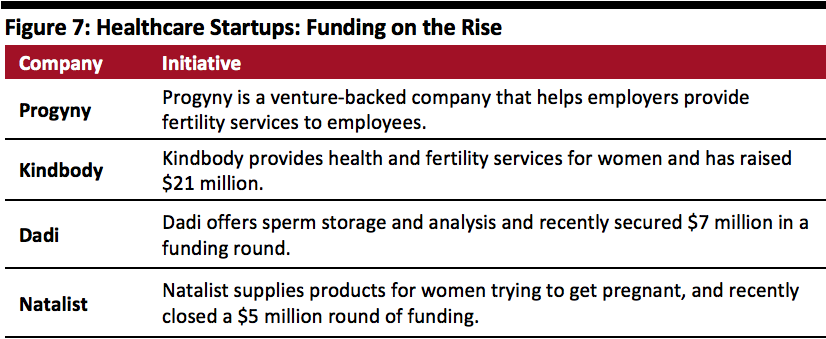 Source: Company reports/Coresight Research
Source: Company reports/Coresight Research[/caption]
5. Environmental concerns will drive a proliferation of sustainable fashion initiatives and partnerships
More companies will focus on sustainability as consumers increasingly embrace environmental issues and look to brands to follow suit. We’ll see more sustainable products, services and processes.
The apparel industry is now said to be the second-largest polluter in the world, beset by energy-intensive processes, high water consumption, use of non-renewable resources and general excess. In the last 15 years, the industry has doubled production, but the average length of time an article of clothing is worn before being discarded plummeted 40%.
According to global non-profit organization BSR, 93% of global consumers want to see more of the brands they buy from support environmental issues, and three of four teenagers want to buy more sustainable products. Many retailers are already working on sustainability initiatives.
To cut waste, some companies have introduced initiatives focused on recycling and reuse:
[caption id="attachment_102547" align="aligncenter" width="580"]
 Source: Company reports/Coresight Research
Source: Company reports/Coresight Research[/caption]
Startups will continue to disrupt the industry with innovative, sustainably based approaches to retail manufacturing.
Some startups to watch include:
[caption id="attachment_102548" align="aligncenter" width="580"]
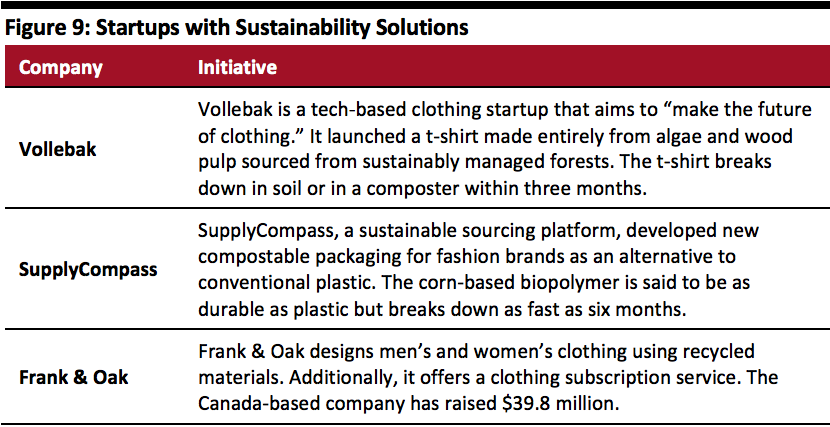 Source: Company reports/Coresight Research
Source: Company reports/Coresight Research[/caption]
6. Reality tech will continue to blur the line between digital experiences and the real world
Retailers will increasingly rely on extended reality to engage customers browsing products. Virtual models of the human form, either created through 3D technology or otherwise, will progressively guide purchasing decisions. Innovative practices will continue to disrupt the industry with various approaches to retail operations, including:
[caption id="attachment_102549" align="aligncenter" width="580"]
 Source: Company reports/Coresight Research
Source: Company reports/Coresight Research[/caption]
In 2020, the extended reality space will allow more consumers to share their VR shopping experience with friends. A growing number of companies will create 3D environments and experiences to establish increased immersion spaces. Real estate and travel already use 360-degree videos, and we think they will become more prevalent in retail in 2020.
Collaborations between technology companies and brands and retailers will intensify in 2020.
Here are some existing collaborations:
[caption id="attachment_102550" align="aligncenter" width="580"]
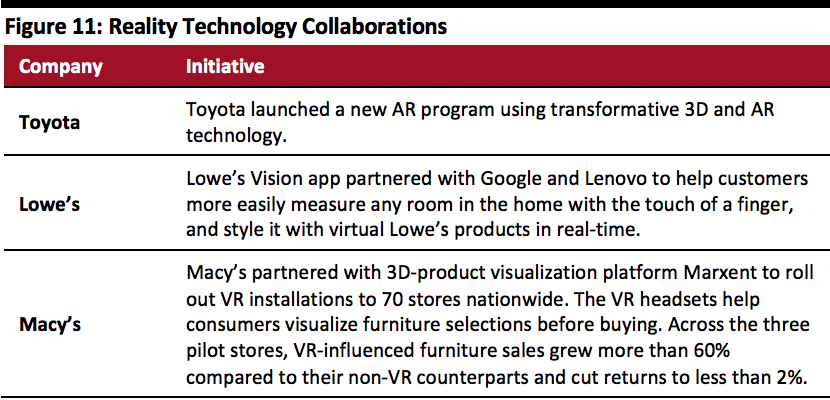 Source: Company reports/Coresight Research
Source: Company reports/Coresight Research[/caption]
7. 5G will be rolled out commercially, boosting digital retail
5G technology, the fifth generation of mobile connectivity, is expected to bring faster speed, higher capacity, greater responsiveness and better dependability. This major upgrade in the network will allow companies to improve e-commerce operations and increase the efficiency of in-store technology, generating higher sales conversion.
The advent of 5G in 2020 will reduce barriers to entry, as processes shift to the cloud and smartphones are able to serve as AR devices. This will greatly boost AR technologies and further increase pressure on brick-and-mortar retailers to keep consumers coming back with experiential benefits.
The widespread use of 5G technology will also enable shoppers to browse websites faster, shop on the go more seamlessly and engage in more personalized online experiences. Adobe says there is a relationship between connection speed and online conversion, and predicts increased network speeds will generate an additional $12 billion per year for US online retailers by 2021.
[caption id="attachment_102551" align="aligncenter" width="700"]
 Source: Adobe Analytics
Source: Adobe Analytics[/caption]
The introduction of 5G networks will allow e-commerce apps to use more data intense programs using AI and machine learning, as well as a higher reliance on AR and VR.
5G connectivity will also enable new applications such as tactile Internet, the ability to emulate the sensation of touch through connected devices, potentially creating features such as shoppers being able to feel fabrics through a connected device.
House of Holland fashion designer Henry Holland worked with UK network
Three to create “a living room of the future,” offering an immersive experience at the network's central London store on Oxford Street. The new set-up includes mindfulness experiences offered through 5G connections, a spaceship gaming battle and a shopping experience.
Nokia will power Swedish telecom
Telia’s 5G network at the new
Mall of Tripla shopping center in Helsinki, part of the city’s smart city project. The 5G network will deliver next-generation connectivity throughout the three-block urban shopping mall and business center, enabling retailers to implement novel retail applications and lifestyle experiences.
8. Voice tech development will become more brand oriented
The expansion of virtual assistants such as Amazon’s Alexa, Apple’s Siri and Google Assistant are changing the way we interface with the digital world. In 2020 retailers will use audio tech more: Innovation in audio advertising, sonic logos and branded podcasts are a few of the options available.
- Harrods uses a podcast to bolster its digital presence, engaging potential customers to explore what luxury means today. Although part of its digital growth strategy, it also expands the company’s potential customer base.
- Lululemon runs audio ads varying between 15 and 30 seconds in length via Amazon Alexa (to users who don’t subscribe to ad-free Prime).
NPR and Edison Research’s Smart Audio Report shows the number of devices in homes increased 78% in 2018 from the prior year, while Adobe’s latest State of Voice Assistants report indicates 32% of consumers now own a smart speaker, up from 14% in January 2018.
[caption id="attachment_102552" align="aligncenter" width="700"]
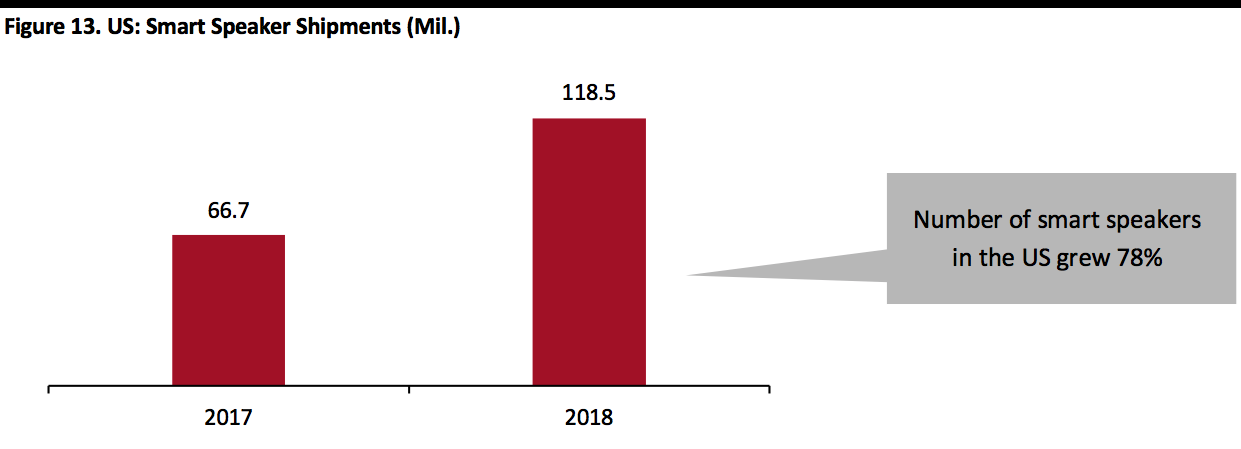 Source: NPR/Edison Research
Source: NPR/Edison Research[/caption]
Despite its growth, voice assistant technology is still a largely untapped resource with tremendous potential. A recent study by OC&C Strategy Consultants forecasts global voice commerce sales to rise to about $40 billion by 2022 from just $2 billion today.
2020 will see an expansion of voice shopping in the retail sector.
- Mmuze is extending voice shopping to grocery retailers, allowing them to compete directly with Amazon’s Alexa voice-based grocery shopping. The Israel-based conversational artificial intelligence company offers online grocery retailers a platform that provides a natural conversational experience. Mmuze’s platform-agnostic solutions already power cross-channel commerce for leading online retail brands, including ASOS, Perry Ellis and US Polo.
- Nike’s digital performance expert Nike Coach uses Google Assistant to chat with shoppers to help them find sneakers. It also uses Apple’s Siri voice assistant to tighten and release laces on Nike’s new Adapt Huarache sneakers, while Nike’s FitAdapt software and Nike Adapt app also turn the shoes into another voice-controlled Internet of Things device.
- 1-800 Flowers became one of the first retailers to use Samsung’s Bixby to enable voice shopping, and to pay with Samsung Pay, in early 2019.
9. Banking-as-a-service (BaaS) and digital payment solutions will see exceptional growth
Digital banking will finally take off in the west, catching up with a trend that started in China years ago. Digital payment solutions will primarily focus on:
- Enabling phone or smartwatch purchases.
- Establishing ecosystems that unlock customer insights and forge loyalty by providing convenience, value and security.
- Implementing facial recognition.
- Allowing for more seamless, convenient, fast, and secure transactions.
Retailers are gradually adopting digital payment systems: 7-Eleven, Target and Costco all introduced mobile wallets as payment options in 2018.
[caption id="attachment_102553" align="aligncenter" width="580"]
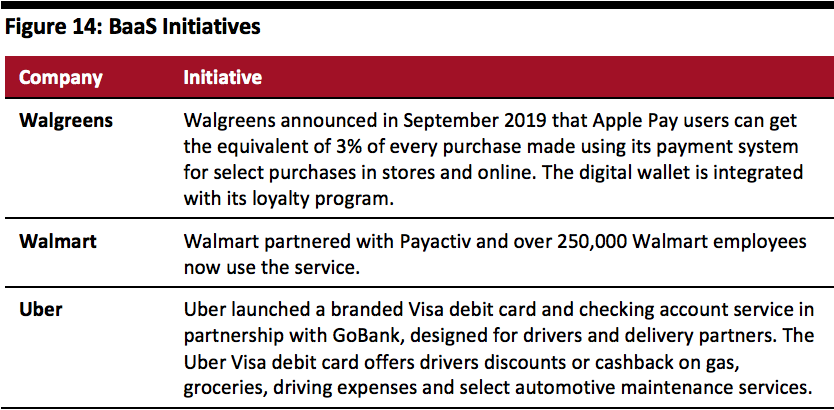 Source: Company reports/Coresight Research
Source: Company reports/Coresight Research[/caption]
BaaS companies such as Marqeta, GreenDot and Metabank will disrupt retail with services such as advance pay for employees, co-branded debit cards and other innovative payment methods.
[caption id="attachment_102554" align="aligncenter" width="580"]
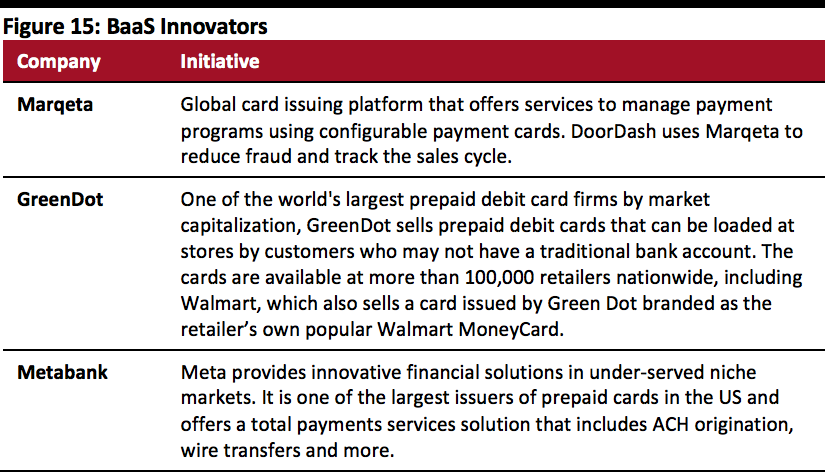 Source: Company reports/Coresight Research
Source: Company reports/Coresight Research[/caption]
Digital payment solutions have found a powerful strategic partner in the automobile industry. Auto manufacturers are dropping digital wallets into cars, which then fuels further changes in consumer behavior.
- Honda Motor introduced Honda Dream Drive, which uses the car’s onboard infotainment display to enable payments at drive-through restaurants, gas stations, smart parking lots and grocery stores. BMW, Ford Motor, General Motors, Hyundai and Volkswagen have also announced they will offer in-car payment technology.
These integrated wallets will greatly facilitate transactions, radically changing behavior and engagement. They will also facilitate retailers’ ability to gather data, understand behavior and create a one-to-one relationship, especially when combined with analytics, AI and geolocation.
10. On-demand customization and 3D printing will lead a boom in personalized products
2020 will see a greater push for mass customization, underpinned by digital design and automation. Hyper-connected consumers, keen on instant gratification, are driving the shift from mass manufacturing to scaled personalized production, making personalization the top success factor for customer and prospect engagement. Retailers can produce a richer variety of goods based on consumers’ individual design tastes with the same efficiency as mass production, allowing every shopper to become a market of one.
Consumers also want apparel that represents who they are and the fact that they share everything online, offering a potential goldmine of information for designers who can adjust production to match what customers actually desire. For manufacturers, the challenge is in catering to the demand for personalization at a faster pace and on a greater scale.
- Lectra, a fashion retail software company, has created two solutions to meet demand for faster turnaround on personalized items. Cutting room 4.0 combines a cloud-based data hub that connects product development offices with a single-ply cutting machine that offers a 360-degree view of the whole process to create a full cutting line with systems able to communicate with each other. Its Fashion On Demand technology is designed as a comprehensive personalization solution with a 360-degree view of the process to streamline multiple production processes and manage complex individual demands.
Personalization of specific clothing items offers a unique one-of-a-kind look for the customer’s wardrobe while also extending the lifetime of the piece.
[caption id="attachment_102555" align="aligncenter" width="580"]
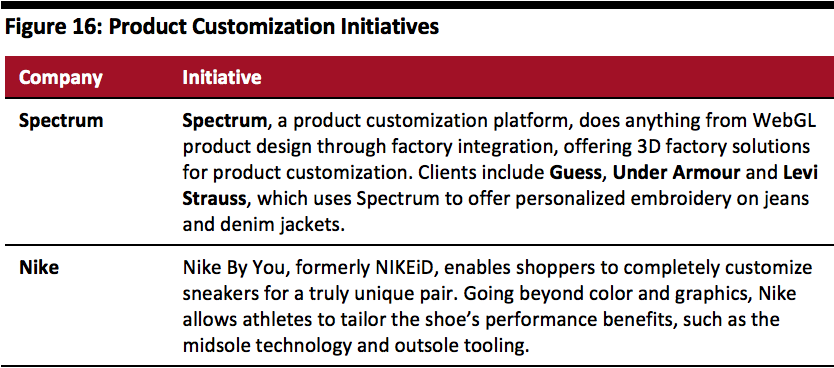 Source: Company reports/Coresight Research
Source: Company reports/Coresight Research[/caption]
For more on what's coming in retail in 2020, see the Coresight Research report
Retail 2020: 10 Trends for China E-Commerce and
Retail 2020: Five Forces, 10 Trends in Global Retail.
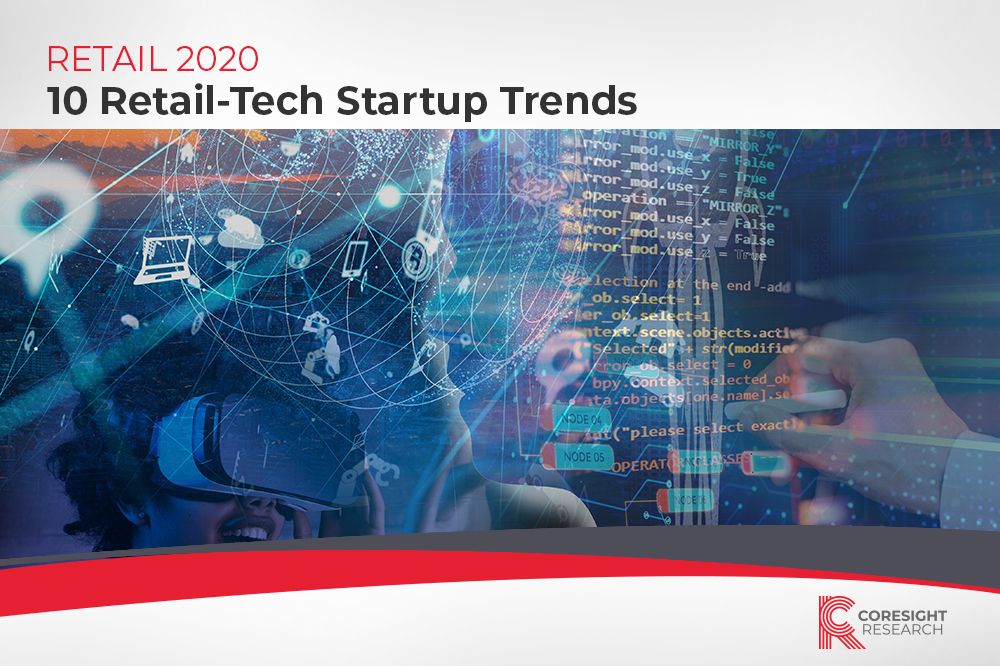
 1. Autonomous robots will gain traction in last-mile delivery
1. Autonomous robots will gain traction in last-mile delivery Source: Company reports/Coresight Research[/caption]
Aerial delivery drones will finally see more use, led by Amazon, UPS, Uber, and Google’s Wing. Major retailers are also investing in drone technology for last-mile delivery.
[caption id="attachment_102541" align="aligncenter" width="580"]
Source: Company reports/Coresight Research[/caption]
Aerial delivery drones will finally see more use, led by Amazon, UPS, Uber, and Google’s Wing. Major retailers are also investing in drone technology for last-mile delivery.
[caption id="attachment_102541" align="aligncenter" width="580"] Source: Company reports/Coresight Research[/caption]
Source: Company reports/Coresight Research[/caption]
 Source: Company reports/Coresight Research[/caption]
The increased limitations on harvesting consumer data also mean contextual marketing—which thrives on consumer engagement based on real-time behavior—will have to shift data collection to be less invasive. We expect more solution providers to offer more data collection tools to comply with these new requirements while also delivering results.
Source: Company reports/Coresight Research[/caption]
The increased limitations on harvesting consumer data also mean contextual marketing—which thrives on consumer engagement based on real-time behavior—will have to shift data collection to be less invasive. We expect more solution providers to offer more data collection tools to comply with these new requirements while also delivering results.
 Source: Wolfe Research[/caption]
Retailers are already implementing robotics in daily operations, often in collaboration with technology firms.
These are some companies to watch in 2020:
[caption id="attachment_102544" align="aligncenter" width="580"]
Source: Wolfe Research[/caption]
Retailers are already implementing robotics in daily operations, often in collaboration with technology firms.
These are some companies to watch in 2020:
[caption id="attachment_102544" align="aligncenter" width="580"] Source: Company reports/Coresight Research[/caption]
Source: Company reports/Coresight Research[/caption]
 Source: Company reports/Coresight Research[/caption]
2020 will likely see more activity in this space as the majority of millennials cross into their thirties and start families of their own. Startups innovating around fertility and reproductive health have raised a lot of venture capital. Here are some examples:
[caption id="attachment_102546" align="aligncenter" width="580"]
Source: Company reports/Coresight Research[/caption]
2020 will likely see more activity in this space as the majority of millennials cross into their thirties and start families of their own. Startups innovating around fertility and reproductive health have raised a lot of venture capital. Here are some examples:
[caption id="attachment_102546" align="aligncenter" width="580"] Source: Company reports/Coresight Research[/caption]
Source: Company reports/Coresight Research[/caption]
 Source: Company reports/Coresight Research[/caption]
Startups will continue to disrupt the industry with innovative, sustainably based approaches to retail manufacturing.
Some startups to watch include:
[caption id="attachment_102548" align="aligncenter" width="580"]
Source: Company reports/Coresight Research[/caption]
Startups will continue to disrupt the industry with innovative, sustainably based approaches to retail manufacturing.
Some startups to watch include:
[caption id="attachment_102548" align="aligncenter" width="580"] Source: Company reports/Coresight Research[/caption]
Source: Company reports/Coresight Research[/caption]
 Source: Company reports/Coresight Research[/caption]
In 2020, the extended reality space will allow more consumers to share their VR shopping experience with friends. A growing number of companies will create 3D environments and experiences to establish increased immersion spaces. Real estate and travel already use 360-degree videos, and we think they will become more prevalent in retail in 2020.
Collaborations between technology companies and brands and retailers will intensify in 2020.
Here are some existing collaborations:
[caption id="attachment_102550" align="aligncenter" width="580"]
Source: Company reports/Coresight Research[/caption]
In 2020, the extended reality space will allow more consumers to share their VR shopping experience with friends. A growing number of companies will create 3D environments and experiences to establish increased immersion spaces. Real estate and travel already use 360-degree videos, and we think they will become more prevalent in retail in 2020.
Collaborations between technology companies and brands and retailers will intensify in 2020.
Here are some existing collaborations:
[caption id="attachment_102550" align="aligncenter" width="580"] Source: Company reports/Coresight Research[/caption]
Source: Company reports/Coresight Research[/caption]
 Source: Adobe Analytics[/caption]
The introduction of 5G networks will allow e-commerce apps to use more data intense programs using AI and machine learning, as well as a higher reliance on AR and VR.
5G connectivity will also enable new applications such as tactile Internet, the ability to emulate the sensation of touch through connected devices, potentially creating features such as shoppers being able to feel fabrics through a connected device.
House of Holland fashion designer Henry Holland worked with UK network Three to create “a living room of the future,” offering an immersive experience at the network's central London store on Oxford Street. The new set-up includes mindfulness experiences offered through 5G connections, a spaceship gaming battle and a shopping experience.
Nokia will power Swedish telecom Telia’s 5G network at the new Mall of Tripla shopping center in Helsinki, part of the city’s smart city project. The 5G network will deliver next-generation connectivity throughout the three-block urban shopping mall and business center, enabling retailers to implement novel retail applications and lifestyle experiences.
Source: Adobe Analytics[/caption]
The introduction of 5G networks will allow e-commerce apps to use more data intense programs using AI and machine learning, as well as a higher reliance on AR and VR.
5G connectivity will also enable new applications such as tactile Internet, the ability to emulate the sensation of touch through connected devices, potentially creating features such as shoppers being able to feel fabrics through a connected device.
House of Holland fashion designer Henry Holland worked with UK network Three to create “a living room of the future,” offering an immersive experience at the network's central London store on Oxford Street. The new set-up includes mindfulness experiences offered through 5G connections, a spaceship gaming battle and a shopping experience.
Nokia will power Swedish telecom Telia’s 5G network at the new Mall of Tripla shopping center in Helsinki, part of the city’s smart city project. The 5G network will deliver next-generation connectivity throughout the three-block urban shopping mall and business center, enabling retailers to implement novel retail applications and lifestyle experiences.
 Source: NPR/Edison Research[/caption]
Despite its growth, voice assistant technology is still a largely untapped resource with tremendous potential. A recent study by OC&C Strategy Consultants forecasts global voice commerce sales to rise to about $40 billion by 2022 from just $2 billion today.
2020 will see an expansion of voice shopping in the retail sector.
Source: NPR/Edison Research[/caption]
Despite its growth, voice assistant technology is still a largely untapped resource with tremendous potential. A recent study by OC&C Strategy Consultants forecasts global voice commerce sales to rise to about $40 billion by 2022 from just $2 billion today.
2020 will see an expansion of voice shopping in the retail sector.
 Source: Company reports/Coresight Research[/caption]
BaaS companies such as Marqeta, GreenDot and Metabank will disrupt retail with services such as advance pay for employees, co-branded debit cards and other innovative payment methods.
[caption id="attachment_102554" align="aligncenter" width="580"]
Source: Company reports/Coresight Research[/caption]
BaaS companies such as Marqeta, GreenDot and Metabank will disrupt retail with services such as advance pay for employees, co-branded debit cards and other innovative payment methods.
[caption id="attachment_102554" align="aligncenter" width="580"] Source: Company reports/Coresight Research[/caption]
Digital payment solutions have found a powerful strategic partner in the automobile industry. Auto manufacturers are dropping digital wallets into cars, which then fuels further changes in consumer behavior.
Source: Company reports/Coresight Research[/caption]
Digital payment solutions have found a powerful strategic partner in the automobile industry. Auto manufacturers are dropping digital wallets into cars, which then fuels further changes in consumer behavior.
 Source: Company reports/Coresight Research[/caption]
For more on what's coming in retail in 2020, see the Coresight Research report Retail 2020: 10 Trends for China E-Commerce and Retail 2020: Five Forces, 10 Trends in Global Retail.
Source: Company reports/Coresight Research[/caption]
For more on what's coming in retail in 2020, see the Coresight Research report Retail 2020: 10 Trends for China E-Commerce and Retail 2020: Five Forces, 10 Trends in Global Retail.